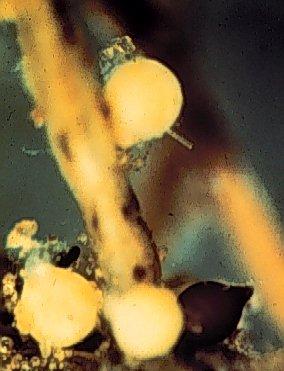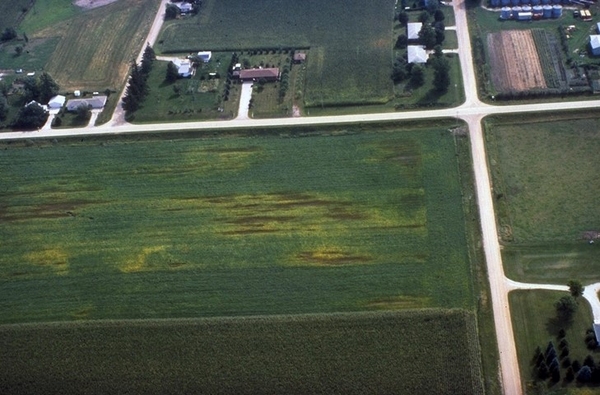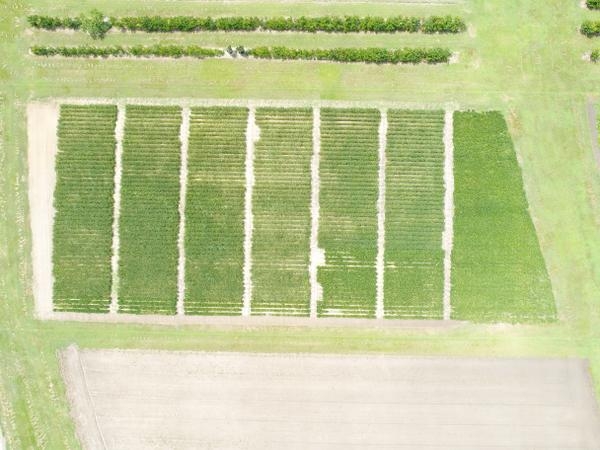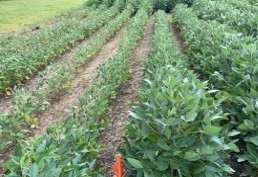Introduction
Soybean cyst nematode (SCN) was first reported in the United States (U.S.) in 1954 in New Hanover County, North Carolina. Since then, SCN has spread to almost all soybean-growing regions in the U.S. and is one of the most destructive pathogens affecting soybean production. SCN can cause substantial yield and economic losses acrossthe U.S., resulting in estimated annual losses of over one billion dollars. In North Carolina, the highest populations of SCN have previously been found throughout the coastal plains, as the nematode prefers sandy soil type. However, SCN can establish and cause yield loss in any soil type.
Unlike some other types of nematodes such as lesion (Pratylenchus spp.) and root-knot (Meloidogyne spp.) nematode, SCN has a narrow host range. Soybean cyst nematode only infects soybean and other bean crops.
Cause-Nematode and Life Cycle
Soybean cyst nematode (Heterodera glycines) is a microscopic, plant-parasitic roundworm. The nematode damages the soybean roots by penetrating, feeding and reproducing on the root tissue. SCN is primarily spread through the movement of soil and, once established in favorable conditions, the nematode can reproduce rapidly. SCN has three main stages of its life cycle consisting of an egg, a juvenile stage, and the adult stage. This cycle can often be repeated numerous times throughout the season in favorable environments as egg development occurs 21 to 28 days after juvenile establishment in the root. Optimal conditions for numerous life cycles to take place consist of soil temperatures between 75- and 82-degrees Fahrenheit. In North Carolina, there may be up to five SCN generations in one year.
SCN eggs develop inside a cyst, which is the body of an adult female. Juvenile nematodes will hatch from an egg and migrate through the soil to root tissue. If there is no root tissue present, the juveniles die within a few weeks. It has been reported that when roots are present the root exudates stimulate the hatching of eggs and attraction of the juveniles to the root systems. The juveniles then penetrate the roots using a stylet, a hollow spear-like mouth structure. The juvenile penetration alone can result in considerable damage resulting in increased susceptibility to other soil-borne diseases that may be cause by opportunistic pathogens such as Fusarium, Phytophthora, Pythium, Rhizoctonia, and Macrophomina. The juvenile continues to penetrate the root and migrate towards the vascular tissue to locate and establish a feeding site called a syncytium. Once established, the nematode becomes sedentary. Nutrients are then diverted from the host to the nematode resulting in nutritional deficiencies of the soybean. The sedentary nematode molts three time developing into the adult female stage. The adult male nematodes migrate to the sedentary females to fertilize the female. After fertilization, eggs develop within the female increasing in size. The nematodes body will break through the roots of the soybean forming a yellow, lemon-shaped cyst on the root of the soybean. As the female matures and egg development stops, the cyst turns brown and detaches from the root. Cysts can contain anywhere from 25 eggs to 200 eggs and can survive for many years within the soil.
Population and Races
Different populations of SCN have evolved to overcome resistant soybean cultivars, and these populations were historically characterized as races 1 through 16. However, the race classification scheme was limited in the type of virulent populations that it could describe. Therefore, a new classification scheme called the “HG Types” was developed and named after the genus and species name of SCN (Heterodera glycines). HG Types, while conceptually similar to races, use a more robust test to characterize SCN populations that includes seven different breeding lines conferring different sources of resistance to SCN. These breeding lines consist of Peking, PI88788, PI90763, PI437654, PI209332, PI89772, and Cloud. Understanding HG Type population distribution and levels within a field can assist with selecting resistant soybean varieties. PI88788 has been widely used as the primary source of resistance putting pressure on nematode populations adapting to overcome resistance. Therefore, it is recommended to rotate resistant varieties with the different breeding backgrounds.
A soil survey conducted in 2017 for better understanding of what HG Types were predominant in soybean fields in North Carolina. Of the 18 counties sampled in the survey, HG Type 1.2 (87%), HG Type 1.2.3 (10%), and HG Type 2 (3%) were identified.
Signs and Symptoms
As with many nematode issues, SCN can often go undetected due to subtle or complete lack of above ground symptoms. Even without conspicuous above ground symptoms, studies have reported yield losses up to 30% in infested fields. If and when symptoms are seen they may appear as patches and/or “hot spots” distributed throughout the field. Above ground symptoms of SCN in these hot spots may include stunting, wilting, chlorosis (yellowing)The hot spots are often stunted, and yellowing soybeans typically seen in elliptical shaped patterns.
Signs (the visual indication of the pathogen itself) of SCN can be seen below ground often in the middle to late part of the growing season. White or cream colored lemon-shaped SCN cysts on the soybean root can be seen with the naked eye. The cysts are approximately the size of a pen tip or smaller. As the cysts mature, they will turn from yellow to brown.
Sampling and Diagnosis
If SCN is suspected in a field, a few plants should be dug up, taking care to handle the root system gently – SCN cysts are loosely attached to the outside of the root and may become dislodged. Visually inspect the roots, looking for the cysts. Use of a hand lens or magnifying glass can help you look for the small cysts. Although the presence of SCN cysts on the soybean roots is sufficient to diagnose SCN in the field, this will not indicate the level of SCN pressure (nematode population counts) in the field. Diagnosis can be confirmed through assessment of soil samples for SCN by a plant disease diagnostic laboratory or nematode assay laboratory.
Soil sampling for SCN is important to document the presence, distribution, and population levels within the field. Understanding the risk SCN poses within the field will help determine what management tools are best to employ. Soil sampling for nematode analysis is recommended either in the spring before planting to make management decisions for the current season, or in the fall at harvest time, to prepare for the next cropping cycle. Soil samples should be collected using a hand trowel or soil probe of at least 1-inch diameter, to a depth of 6 to 8 inches. Soil samples conducted prior to harvest should be angled towards the root zone.
Since SCN distribution within a field is generally uneven, there are different strategies to determine where locations of soil samples should be taken. It is recommended that for each of these, one composite sample be collected for each 4-5 acre block being sampled.
1.) If sampling a field for SCN for the first time: target high risk areas or areas where the nematode could first be int4–5-acre (i.e., flooded areas, low spots, and field entryways);
2.) If sampling to determine egg counts in fields known to have SCN- separate the field into 4–5-acre sections and collect 20 to 30 soil samples in a zig-zag pattern throughout each section. Bulk soil cores together and remove one composite sample for analysis.
3.) To evaluate effectiveness of management tools- divide the field into sections and monitor populations as different management practices are used.
Management
Management of SCN is best accomplished using an integrated approach including tactics such as reducing the spread of SCN from field to field, soil sampling and monitoring, planting resistant varieties, rotating to non-host crops, and using a nematicide treatments where economically feasible. Using an integrated “toolbox” approach reduces reliance on a single tactic, minimizes costs, and minimizes risk of developing resistance to a variety or pesticide.
Cultural Practices
SCN is not seedborne, but rather is spread through the movement of infested soil from field to field. Cleaning equipment between fields can limit the rate of the spread of SCN. Proactive scouting and soil sampling can provide early detection of SCN that can be critical when making informed management decisions. Crop rotation with non-host crops (corn, cotton, tobacco, peanut, sorghum, and most vegetables) is the most effective management tool used to reduce SCN population levels. Incorporating a management plan that rotates crops and resistant varieties with varying SCN resistant genetics can keep populations at manageable levels.
In North Carolina, soybean maturity group may also contribute to the degree of SCN reproduction in the fall. Late maturing group like VII and VIII, which mature in late October or November in North Carolina, allows for additional generations of SCN to develop on the living plant roots. Under optimal conditions, this can double or triple the nematode population. Reducing this reproduction by using a earlier maturity group can help to keep population levels of SCN low for following years.
Host Resistance
Planting SCN-resistant soybean varieties can limit SCN reproduction, thus minimizing egg levels for following growing seasons. Using resistant varieties will protect yield in the current season as well as preventing further yield loss in future seasons and this technique will be more effective if the variety is planted according to the SCN HG-type. The HG-type is a classification system that allows categorization of different SCN populations based on what known soybean resistance the population overcomes. The newer HG-type system of classifying SCN population replaces an older, narrower SCN race system. Even if the exact HG-type is not known, use of a soybean variety with some resistance will reduce SCN reproduction compared to a fully susceptible variety. However, repetitive use of the same resistant variety can consequently result in shift of SCN populations or lead to the nematodes ability to adapt to the resistance. Rotating different sources of resistance is important to limit this selection pressure.
Biological and Chemical Management
Nematicide fumigant, in-furrow, seed treatments products are available, though effectiveness is variable, especially under elevated SCN pressure. These chemical controls for SCN and other nematodes are often expensive and may not always results in a yield response. Chemical and biological nematicide produces are summarized in Table 1 and additional information may be found in the North Carolina Agricultural Chemicals Manual.
Additional Resources
- NCDA&CS Nematode Assay Lab provides soil detection and diagnostics
- NC State University Plant Disease and Insect Clinic provides diagnostic and control recommendations
- NC State Extension Plant Pathology portal provides information on crop disease management
- NCCES Educational Resources
- APS Plant Disease Lessons: Soybean Cyst Nematode
- For assistance with a specific problem, contact your local N.C. Cooperative Extension agent.
Publication date: Feb. 19, 2018
Reviewed/Revised: Sept. 11, 2023
N.C. Cooperative Extension prohibits discrimination and harassment regardless of age, color, disability, family and marital status, gender identity, national origin, political beliefs, race, religion, sex (including pregnancy), sexual orientation and veteran status.






